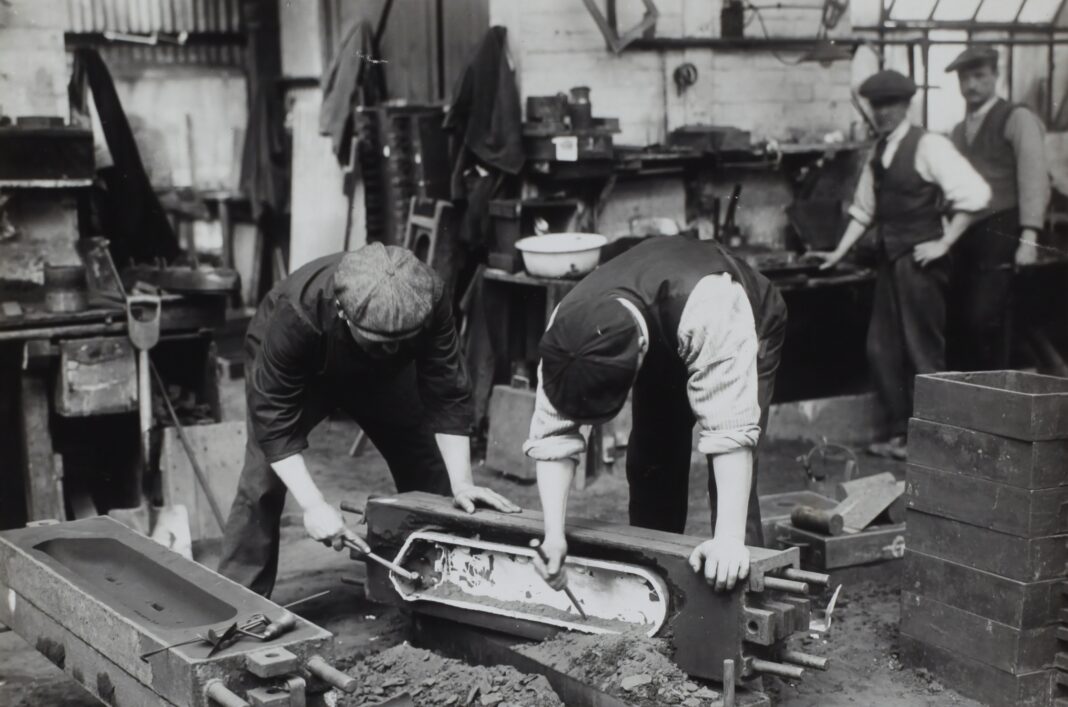The industrial revolution is arguably the single most important event in economic history. Since its start in the 1750s, it has touched almost every aspect of our economic, political, social, and even cultural lives. The question of why the industrial revolution started in Britain in the eighteenth century remains popular among historians. The essay explores the role and significance of coal in industrialization and argues that the availability of coal was important for the industrial revolution because it provided cheaper and more abundant energy, incentivized innovation of technologies crucial for production, and improved transportation systems.
Was the availability of coal important for the Industrial Revolution?
The availability of cheap and accessible coal in Britain is one of the fundamental reasons that instigated the economic processes that we describe as the industrial revolution. The framework that many economic historians use to support this argument is the comparison between Britain, which actively used coal as a source of energy, and other successful economies in Europe and China, which adopted coal later.
Britain’s success in the global economy resulted in rapid urbanization and the popularization of coal as a source of energy. As early as the sixteenth century, industries like the woolen cloth industry produced a surplus that could be sold overseas. Trade through London increased and so did its population. In 1500, the city had 50 000 residents, which exploded to half a million in 1700. As the British empire and trade opportunities expanded, London’s population doubled in the following century. With the growth of London, the price of wood fuels also increased. For example, already by the end of the sixteenth century, charcoal and firewood were twice the price of coal per unit of energy, which led to the popularization of coal and large-scale coal mining in the country (Allen, 2011).
The transition to coal increased the available energy resources, which were crucial for large-scale production. As British historian Edward Anthony Wrigley writes in Energy and the English Industrial Revolution: “The potential gap between the energy required and the energy available was met by increasing coal use in England, which in turn implies that its relative importance rose as time passed. In the later stages of the transition, it was of much greater significance than in the early stages. Above all, access to coal meant that the rate of growth could be maintained or even accelerated rather than having slow down, as was otherwise unavoidable … the initial achievement of prolonged exponential growth in material production, the central feature of the industrial revolution, was based on coal as an energy source” (2010, p. 243-244). In other words, the use of coal provided a cheaper and greater amount of energy vital for industrialization. Cheap energy enabled engineers to develop energy-intensive technologies necessary for large-scale production. Based on this argument, Wrigley deduces that the industrial revolution would never happen in a country with an organic economy (Wrigley, 2010, p. 193).
Another British economic historian, Robert C. Allen, in Why the Industrial Revolution was British: Commerce, Induced Invention, and the Scientific Revolution explain the crucial role coal played in the industrial revolution. He argues that high wages and the low cost of coal were the decisive factors why the industrial revolution took place in Britain and not in more successful economies (2011, p. 364). Due to the black death and success in the pre-industrial global economy, workers’ wages in Britain were relatively high. Moreover, the country had large and easily worked coal deposits, especially in northern and western Britain. For instance, during the early 1700s, Newcastle had the highest ratio of labor costs to energy costs in the world, largely because of the massive and easily accessible coal. The situation was similar in other industrial cities, such as Sheffield and Birmingham. The only place outside Britain with a comparable ratio was Belgium, particularly its coal mining district around Liège and Mons but overall, in 1800, Belgian coal output was hardly 13 percent of Britain’s. Britain’s cheap coal and relatively higher wages created a demand for energy-intensive technologies (Allen, 2011, p. 365).
The importance of coal to the industrial revolution is perfectly demonstrated by comparing Britain to similar economies that used other energy sources. Various cities in Western Europe enjoyed similar socio-economic circumstances as London in the eighteenth century but, according to Allen, Britain’s pioneering transition to coal gave it the advantage over other countries. He contrasts the British transition to coal with the Dutch cities, which adopted it later. Although rapid urbanization was happening in the Netherlands, they initially chose to use Dutch peat to satisfy the increased demand for fuel. This decision prevented the development of transportation to the nearby local and neighboring countries, mainly in Germany, coal deposits. As the Newcastle coal industry improved, coal could be delivered to continental Europe as cheaply as in London, further postponing the development of Dutch and German coal. Allen comments that “had German coal been developed in the sixteenth century rather than the nineteenth, the industrial revolution might have been a Dutch-German breakthrough rather than a British achievement” (2011, p. 366). This comparison between British and similarly economically successful European cities demonstrates how an early transition to coal was economically advantageous for Britain and played an important role in the industrialization process.
Allen, as well as other economic historians, either directly state or imply that Britain’s success in the industrial revolution was partially due to its geographic luck. For example, Kenneth Pomeranz, in The Great Divergence: China, Europe, and the Making of the Modern World Economy, investigates why the industrial revolution did not occur in China, the richest pre-industrial economy. He stresses the importance of coal and argues that in Britain and other parts of western Europe, coal deposits were located in the economically dynamic parts of the countries while in China, coal was in the north and northeast, far from the country’s economic centers in the south (Pomeranz, 2021, p.59-65).
Why was the availability of coal important for the Industrial Revolution?
Wrigley (2010) explains how coal providing cheaper and more energy was detrimental to industrialization. He describes all economies before the industrial revolution as organic economies. Organic designates the energy produced by photosynthesis in plants, which was the main source of energy and, due to its limited quantity, constrained human activities. In classical economic theories, there are three necessary requirements for production: capital, labor, and land. Theoretically, the supply of capital and labor can be provided indefinitely, but the land is fixed. Agriculture was the primary source of producing food as well as raw materials, such as wool, leather, and wood. Under these circumstances, making metals was difficult and restraining. It required a large supply of heat, which came from burning wood and charcoal for smelting mineral ores. Increasing the production of metals or other materials needed more land, and it was difficult since most of the land, particularly productive ones, was already occupied.
Wrigley (2010) points out the irony that coal that replaced the old source of energy is also a product of plant photosynthesis but in this case, coal formation took many millions of years. The transition to coal solved the problem of limited land and allowed larger-scale production and, eventually, industrialization. Industries requiring a greater amount of heat had more incentive to replace wood with coal and reduce production costs. For that reason, many industries, such as salt boiling or brewing, straightforwardly adopted coal. Moreover, coal enabled early modern England to mass produce brick and turned it into a main building material.
Another example of a production that was possible because of cheap energy was glass manufacturing. Arthur Young, an English traveler in the eighteenth century was surprised by the absence of glass in France. “Of many houses too good to be called cottages, without any glass windows,” wrote Young (Wrigley, 2010, p.40). All these new products and materials were the result of cheaper and abundant energy from burning coal.
Cheap coal energy created an opportunity for unprecedented technological innovations that enabled industrialization. The majority of the technologies created during the industrial revolution, especially in its early stages, depended on coal. Arguably, one of the most important inventions at that time was the coal-fired steam engine. In early modern England, one of the biggest problems with working in large-size coal mines was water accumulation. Traditionally they used wind, water, and horsepower to solve this problem but later, it led to the invention of the steam engine. Wrigley explains that “the contemporary recognition that improving access to deeper coal measures was crucial to many industries is reflected in the fact that in the first three decades after the Restoration, more than two-fifths of all the patents granted were for steam engines to pump water out of mines and for methods of using coal instead of charcoal to smelt metals” (2010, p.45). In other words, the water accumulation problem of coal mining created an incentive for British engineers to develop modern technologies, which affected not only coal mining but other aspects of the industrial revolution. Eventually, due to the work of James Watt, the Scottish engineer, and his business partner, Matthew Boulton, steam engines achieved the level of sophistication to make them a better alternative to water power. The steam engine had many advantages, including the freedom it gave factories to move to industrial cities and not being tied to rivers (National Geographic Society, n.d.).
Allen explains how the coal-incentivized invention of the steam engine and iron-melting technology in Britain was crucial for industrialization by contrasting it to the French technologies created during the same period. (Similarly to the steam engine, cheap iron depended on the transition to coal as a source of energy.) He argues that French inventions, like paper production and knitting, were important but there is no evidence suggesting that they could have impacted the industrial revolution. “There is no reason to believe that French technology would have led to the engineering industry, the general mechanization of industrial processes, the railway, the steamship, or the global economy. In other words, there was only one route to the twentieth century – and it traversed northern Britain,” writes Allen (2011, p. 381-382).
With the development of the coal industry in northern England, transporting it to other parts of the country and continental Europe made up a large part of the overall costs and significantly limited economic activities. As a result, sophisticated transportation developed, which was crucial not only for the coal industry but for the success of the industrial revolution in general. First, large-scale coal production fostered canal construction. According to economic historians, traffic on most canals was due to coal. Canals reduced coal costs and made it more affordable (Wrigley, 2010, p.43-44). For example, between 1773 and 1790, Lancashire’s coalfield output more than tripled after the Leeds and Liverpool canals (Bogart, 2014). It shows how these waterways drastically increased the accessibility and movement of coal in a short period of time. Second, it fundamentally advanced land transportation. In the seventeenth century, rail transport was adopted to transport coal. The development of railways inspired a significant technological change to fully capitalize on the invention. In the following century, iron rails were expanded because roads were uneven. Moreover, the desire for traction created a market for locomotives (Allen, 2011, p. 372).
There are economic historians who dispute the claim that coal affected the industrial revolution in meaningful ways. Gregory Clark and David Jacks in “Coal and the Industrial Revolution, 1700–1869” emphasize the fact that there was no significant improvement in technology or productivity of coal mining, which questions the revolutionary nature of coal for the industrial revolution. “Productivity growth in English coal mining in the Industrial Revolution era was extremely modest even under upper-bound assumptions on productivity gains. The enormous expansion of coal output was due to factors external to the industry: increased demands for coal from greater populations and higher incomes, increased demands following improvements in iron smelting technology, reduced taxation of coal used for domestic purposes in cities like London, and declining real transport costs,” Clark and Jacks (2007, p. 68-69) write. Furthermore, they argue that there was no technological revolution in coal mining , but English coal, used for centuries before industrialization, just found a bigger market.
The industrial revolution made Britain the global superpower and forever changed the way people lived globally. Industrialization was enabled by the adoption of coal as the main source of energy because it was cheaper and more efficient. Coal incentivized engineers to create energy-intensive technologies, such as steam engines and iron-melting technologies. Moreover, coal was crucial in the development of water and land transport, which not only reduced the cost of transportation but also played a significant role in the later phases of the industrial revolution. Despite the commonly shared idea that coal was crucial for the industrial revolution, some economic historians question this hypothesis and argue that coal was used for centuries and state population growth and general economic progress as the reason why coal production increased.
References
Allen, R. C. (2011). Why the Industrial Revolution was British: Commerce, induced invention, and the scientific revolution1. The Economic History Review, 64(2), 357–384. https://doi.org/10.1111/j.1468-0289.2010.00532.x
Bogart, D. (2014). The Transport Revolution in Industrialising Britain. The Cambridge Economic History of Modern Britain, 368–391. https://doi.org/10.1017/cho9781139815017.014
Clark, G., & Jacks, D. (2007). Coal and the Industrial Revolution, 1700-1869. European Review of Economic History, 11(1), 39–72. https://doi.org/10.1017/s1361491606001870
Industrial Revolution and Technology. National Geographic Society. (n.d.). Retrieved January 10, 2023, from https://education.nationalgeographic.org/resource/industrial-revolution-and-technology
Pomeranz, K. (2021). The great divergence: China, Europe and the making of the Modern World Economy. Princeton University Press.
Wrigley, E. A. (2013). Energy and the English Industrial Revolution. https://doi.org/10.1017/cbo9780511779619
Picture Credit: Museums Victoria in Unsplash





